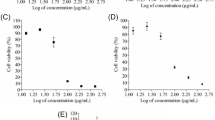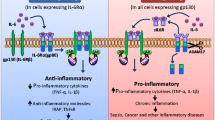Abstract
Cytotoxic chemotherapy dominates the field of cancer treatment. Consequently, anticancer phytochemicals are largely screened on the basis of their cytotoxicity towards cancer cells which are achieved at higher doses, leading to various toxic side effects. Some phytochemicals also showed pro-carcinogenic effects at certain doses. The concept of hormesis has taught us to look into biphasic responses of phytochemicals in a more systematic way. Interestingly, the monoterpenoid alcohol, linalool, also has been reported to display both anti-oxidant and pro-oxidant properties, which prompted us to explore a probable biphasic effect on cancer cells. Cytotoxicity of various concentrations of linalool (0.1–4 mM) was tested on B16F10 murine melanoma cell line, and two sub-lethal concentrations (0.4 and 0.8 mM) were selected for further experiments. 0.4 mM linalool inhibited angiogenesis and metastasis, while 0.8 mM increased them. Similarly, B16F10 cell migration, invasion, and epithelial-mesenchymal transition markers also showed inhibition and induction with lower and higher linalool concentrations, respectively. Chorioallantoic membrane assay, scratch wound assay, and Boyden’s chamber were used to analyze angiogenesis and metastasis. Expression of molecular markers such as vascular endothelial growth factor (VEGF) and its receptor phosphorylated VEGF receptor II (p-VEGFRII or p-Flk-1), Hypoxia-inducible factor-1 α (HIF-1α), E-cadherin, and vimentin were detected using Western blot, ELISA, PCR, qPCR, and immunofluorescence. Finally, ChIP assay was performed to evaluate HIF-1α association with VEGF promoter. Interestingly, measurement of intracellular reactive oxygen species at the selected concentrations of linalool using DCFDA in a flow cytometer showed that the phytochemical induced significant amount of ROS at 0.8 mM. This work sheds light on bimodal dose–response relationship exhibited by dietary phytochemicals like linalool, and it should be taken into consideration to elicit a desirable therapeutic effect.





Similar content being viewed by others
Data availability
The datasets generated during and/or analzsed during the current study are available from the corresponding author on reasonable request.
References
NavaneethaKrishnan S, Rosales JL, Lee KY (2019) ROS-mediated cancer cell killing through dietary phytochemicals. Oxid Med Cell Longev 2019:e9051542. https://doi.org/10.1155/2019/9051542
Fernando W, Rupasinghe HV, Hoskin DW (2019) Dietary phytochemicals with anti-oxidant and pro-oxidant activities: a double-edged sword in relation to adjuvant chemotherapy and radiotherapy? Cancer Lett 452:168–177
Rodenak-Kladniew B, Castro A, Stärkel P, De Saeger C, De Bravo MG, Crespo R (2018) Linalool induces cell cycle arrest and apoptosis in HepG2 cells through oxidative stress generation and modulation of Ras/MAPK and Akt/mTOR pathways. Life Sci 199:48–59. https://doi.org/10.1016/j.lfs.2018.03.006
Kim YW, Byzova TV (2014) Oxidative stress in angiogenesis and vascular disease. Blood J Am Soc Hematol 123(5):625–631
Becker V, Hui X, Nalbach L, Ampofo E, Lipp P, Menger MD, Gu Y (2021) Linalool inhibits the angiogenic activity of endothelial cells by downregulating intracellular ATP levels and activating TRPM8. Angiogenesis. https://doi.org/10.1007/s10456-021-09772-y
Mohamed ME, Abduldaium YS, Younis NS (2020) Ameliorative effect of linalool in cisplatin-induced nephrotoxicity: the role of HMGB1/TLR4/NF-κB and Nrf2/HO1 pathways. Biomolecules 10(11):1488. https://doi.org/10.3390/biom10111488
Deryugina EI, Ratnikov B, Monosov E, Postnova TI, DiScipio R, Smith JW, Strongin AY (2001) MT1-MMP initiates activation of pro-MMP-2 and integrin αvβ3 promotes maturation of MMP-2 in breast carcinoma cells. Exp Cell Res 263(2):209–223. https://doi.org/10.1006/excr.2000.5118
Jonkman JE, Cathcart JA, Xu F, Bartolini ME, Amon JE, Stevens KM, Colarusso P (2014) An introduction to the wound healing assay using live-cell microscopy. Cell Adhes Migr 8(5):440–451. https://doi.org/10.4161/cam.36224
Schmittgen TD, Livak KJ (2008) Analyzing real-time PCR data by the comparative C T method. Nat Protocol 3(6):1101. https://doi.org/10.1038/nprot.2008.73
Eruslanov E, Kusmartsev S (2010) Identification of ROS using oxidized DCFDA and flow-cytometry. In: Advanced protocols in oxidative stress II. Humana Press, Totowa, pp 57–72
Kawaguchi M, Yamamoto K, Kataoka H, Izumi A, Yamashita F, Kiwaki T, Fukushima T (2020) Protease-activated receptor-2 accelerates intestinal tumor formation through activation of nuclear factor-κB signaling and tumor angiogenesis in Apc Min/+ mice. Cancer Sci 111(4):1193. https://doi.org/10.1111/cas.14335
Nelson JD, Denisenko O, Bomsztyk K (2006) Protocol for the fast chromatin immunoprecipitation (ChIP) method. Nat Protocol 1(1):179–185
Rodenak-Kladniew B, Castro MA, Crespo R, Galle M, de Bravo MG (2020) Anti-cancer mechanisms of linalool and 1,8-cineole in non-small cell lung cancer A549 cells. Heliyon 6(12):e05639. https://doi.org/10.1016/j.heliyon.2020.e05639
Iwasaki K, Zheng YW, Murata S, Ito H, Nakayama K, Kurokawa T, Ohkohchi N (2016) Anticancer effect of linalool via cancer-specific hydroxyl radical generation in human colon cancer. World J Gastroenterol 22(44):9765. https://doi.org/10.3748/wjg.v22.i44.9765
Cheng Y, Dai C, Zhang J (2017) SIRT3-SOD2-ROS pathway is involved in linalool-induced glioma cell apoptotic death. Acta Biochim Polon 64(2):343–350
Jana S, Patra K, Sarkar S, Jana J, Mukherjee G, Bhattacharjee S, Mandal DP (2014) Antitumorigenic potential of linalool is accompanied by modulation of oxidative stress: an in vivo study in sarcoma-180 solid tumor model. Nutr Cancer 66(5):835–848. https://doi.org/10.1080/01635581.2014.904906
Park H, Seol GH, Ryu S, Choi IY (2016) Neuroprotective effects of (−)-linalool against oxygen-glucose deprivation-induced neuronal injury. Arch Pharmacal Res 39(4):555–564. https://doi.org/10.1007/s12272-016-0714-z
Kaur T, Kaul S, Bhardwaj A (2018) Efficacy of linalool to ameliorate uremia induced vascular calcification in wistar rats. Phytomedicine 51:191–195. https://doi.org/10.1016/j.phymed.2018.10.007
Seol GH, Kang P, Lee HS, Seol GH (2016) Antioxidant activity of linalool in patients with carpal tunnel syndrome. BMC Neurol 16(1):1–6
Mazani M, Rezagholizadeh L, Shamsi S, Mahdavifard S, Ojarudi M, Salimnejad R, Salimi A (2020) Protection of CCl4-induced hepatic and renal damage by linalool. Drug Chem Toxicol. https://doi.org/10.1080/01480545.2020.1792487
Baschieri A, Ajvazi MD, Tonfack JLF, Valgimigli L, Amorati R (2017) Explaining the antioxidant activity of some common non-phenolic components of essential oils. Food Chem 232:656–663. https://doi.org/10.1016/j.foodchem.2017.04.036
Acknowledgements
This work was funded by Department of Biotechnology (DBT), Govt of India, under the scheme “Pilot Grant for Young Investigators.” We thank DST-FIST, New Delhi, Govt. of India (SR/FST/LSI-585/2014) and DBT-BOOST (49(11)/BT(Estt)/IP-4/2013) for instrumental support. We also express our gratitude towards Bose Institute, Kolkata, West Bengal, India, for kindly allowing us to use the Confocal Microscope.
Funding
The research leading to these results received funding from Department of Biotechnology (DBT), Govt of India, under the scheme “Pilot Grant for Young Investigators” (No. 6242-P3/RGCB/PMD/DBT/SHMB/2015).
Author information
Authors and Affiliations
Contributions
Grant acquisition: SB & DPM, project administration: SB & DPM, conceptualization: SB, DPM, and SJ, methodology and experimentation: PP, SJ and IB, data analysis: PP, SJ, IB, SB, and DPM, figures: PP, SJ, IB, and DPM, writing the original draft: SB, manuscript editing: SB and DPM.
Corresponding authors
Ethics declarations
Conflict of interest
The author declare no competing interests.
Ethical approval
The experiments in this study used commercial cell lines with no permanent transfections. The study does not involve any human participation or animal experimentation. All the experiments were performed without violation of any ethical norms.
Additional information
Publisher's Note
Springer Nature remains neutral with regard to jurisdictional claims in published maps and institutional affiliations.
Supplementary Information
Below is the link to the electronic supplementary material.
Rights and permissions
About this article
Cite this article
Pal, P., Jana, S., Biswas, I. et al. Biphasic effect of the dietary phytochemical linalool on angiogenesis and metastasis. Mol Cell Biochem 477, 1041–1052 (2022). https://doi.org/10.1007/s11010-021-04341-9
Received:
Accepted:
Published:
Issue Date:
DOI: https://doi.org/10.1007/s11010-021-04341-9




